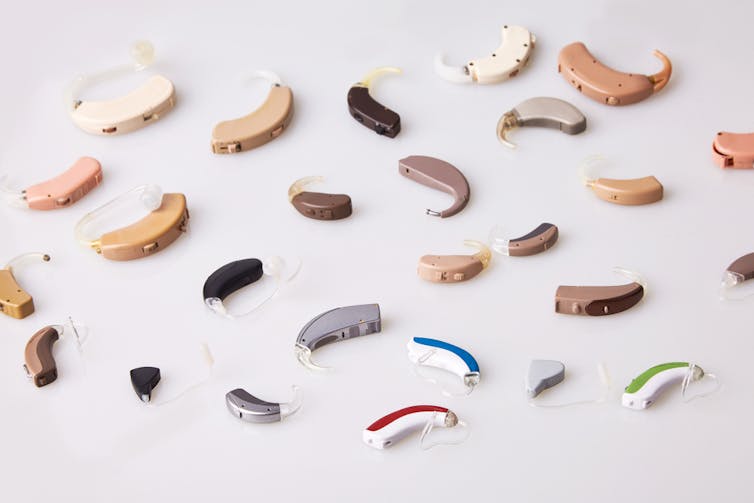Hearing aids are essential for people with hearing loss. But hearing aids have an Achilles heel: their power supply is expensive and environmentally unfriendly.
The good news is that researchers have found an renewable, alternative energy source that might be able to power hearing aids. The energy is produced inside the ear, and harvested using an earplug embedded with sensors.
My PhD project consists of modelling the deformations of the ear canal created by the movements of the jaw. My results will contribute to a better evaluation of the energy that might come from these deformations.
The problem with hearing aids
To understand the problem with hearing aids, consider the daily life of Clara, a 24-year-old architecture student, who has been wearing hearing aids since she was eight years old. When the battery that powers her prosthesis runs out, Clara loses hearing and is cut off from the world.
A part of her brain is constantly on alert to make sure she has a spare box of batteries on hand. In addition to this hassle, the battery is an economic burden. Considering her battery consumption and the price per battery, Clara estimates that in 15 years, the batteries cost more than purchasing a new hearing aid.
The same goes for the cost to the environment. The rare metals used in batteries are not recyclable at this time, and many batteries end up in landfills.
Rechargeable batteries are now widely used for wireless headphones, making it surprising that hearing aids have not embraced this technology. It might sound strange to compare wireless earphones with hearing aids, but in terms of sophistication, the only advantage earphones have over hearing aids is the audio amplifier, which makes it possible to increase sound volume in the ear.
The big difference is price. A single hearing aid costs $1,000-2,000 compared to $100-300 for a pair of headphones. The business model, which involves manufacturers, medical insurers, hearing care professionals and consumers, keeps the price hight.
In short, it’s fair to say that Clara’s financial and environmental balance sheets are not positive. But the revolution is coming! She may soon be able to power her hearing aids with the movement of her jaw.
Our ear canals create energy
Here’s a small experiment: insert your little finger in your ear, then open and close your mouth. Do you feel the pressure change on your fingertip? Jaw movement compresses the tissues around the ear canal, changing its shape. Researchers propose converting this deformation inside the ear into electrical energy.
Several studies have evaluated the amount of energy that comes from this deformation, and have obtained encouraging results. The most recent study reports that up to 22 per cent of the energy needed for the daily operation of a hearing aid can be generated during a 10-minute lunch break.
In other words, the action of eating for 50 minutes would be enough to generate all the energy necessary for a day’s use of the hearing aid. For this experiment, the researchers placed an earplug filled with water in the ear of the participants. They then measured the pressure in the earplug created by the jaw movements. Finally, they translated these pressure variations into deformations of the ear canal.
The human body still holds many surprises. For one, it is a sustainable source of energy available at any time. Just as photovoltaic panels use solar energy, there are now technologies that harvest energy from the human body. This is the case with automatic watches that use the kinetic energy produced by wrist movements.
When it comes to hearing aids, other studies have attempted to convert thermal energy close to the ear or to place a mini solar panel in the ear. But most interest has been in converting energy from ear canal deformations.
In search of the ideal converter
One question remains unanswered: How can the harvested energy be converted and stored? The deformations in the auditory canal are mechanical energy, and the energy can only be stored in a battery after it has been transformed into electric energy.
To solve this problem, researchers have placed ribbons of piezoelectric materials along the perimeter of the earplugs. These materials creating an electric signal when they are deformed.

Unfortunately, the prototypes tested so far do not yet convert enough energy. Some devices come close to the target amount, but they are not small enough to be integrated into a hearing aid. The development of flexible printed circuit boards that can adjust to shapes will make self-powered medical implants possible. With these advances, more efficient converters will begin to emerge.
Will the hearing aid market soon be revolutionized?
If the earplugs of Clara’s hearing aids could convert the deformations of her ear canal into electrical energy, Clara would be able to go about daily life without worrying about recharging her devices. She would know that in case of a power failure, all she has to do is chew gum or hum her favourite song.
This technology could also help reduce the cost of hearing aids, which would be of particular benefit to the 200,000 Canadians with hearing loss who do not use hearing aids because of their high cost.
What’s more, this technology could be extended to all technologies that are worn near or inside the ear, such as wireless headphones or earpieces, digital hearing protectors, in-ear sensors or augmented reality glasses. It doesn’t cost anything to dream!


